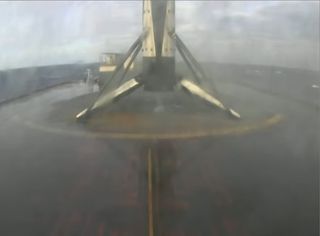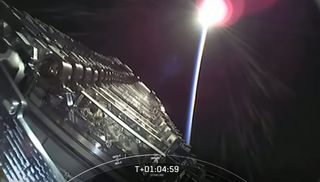SpaceX rocket launches on record 8th flight carrying 60 Starlink satellites, nails landing
It's the most-flown Falcon 9 ever.
CAPE CANAVERAL, Fla. — A SpaceX Falcon 9 rocket launched on a record 8th flight to send a new fleet of the company's Starlink internet satellites into orbit on Wednesday (Jan. 20) and then nailed a landing at sea.
The Falcon 9 rocket lifted off from the historic Pad 39A here at NASA's Kennedy Space Center at 8:02 a.m. EST (1302 GMT) carrying 60 new Starlink satellites for SpaceX's growing constellation in orbit. The launch came after two days of delay due to poor weather in the recovery zone and the need for extra preflight checks.
Approximately 9 minutes after liftoff, the Falcon 9's first stage returned to Earth, landing on one of SpaceX's drone ships in the Atlantic Ocean in a smooth touchdown. The massive ship, "Just Read the Instructions," is one of two in the company’s fleet of recovery vessels that catch falling boosters and return them to port.
Related: SpaceX's Starlink satellite megaconstellation launches in photos




Today's mission was originally planned to blast off Monday (Jan. 18), but was pushed 24 hours to allow for improved weather conditions at the recovery zone. SpaceX relies heavily on its fleet of reused rockets, so the company wants to make sure that each post-launch catch is successful.
On Tuesday (Jan. 19), the company decided it needed another day to put the rocket through some additional prelaunch checkouts as this flight marks the first time that one of the company’s Falcon 9 first stage boosters flew a record 8 times.
The delay proved fruitful as the veteran Falcon 9 leapt off the pad Wednesday for its 8th mission. It landed on "Just Read the Instructions" in the Atlantic Ocean, marking the 72nd landing for a SpaceX rocket.
Get the Space.com Newsletter
Breaking space news, the latest updates on rocket launches, skywatching events and more!
The rocket featured in this launch is one of two record-setting boosters in SpaceX's Falcon 9 fleet. Known as B1051, this flight-proven booster is the first of SpaceX's fleet to make an 8th flight. It also marks one of SpaceX's shortest turnaround times between flights, as this particular booster last flew just over a month ago on Dec. 13.
To date, B1051 has carried an assortment of payloads, including an uncrewed Crew Dragon spacecraft to the International Space Station as part of a 2019 flight test, followed by a trio of Earth-observing satellites for Canada as well as four different Starlink missions. In its Dec. 13 flight, the rocket carried a 15,432-lb. (7,000 kilograms) satellite into orbit for Sirius XM, that will beam down content to Sirius subscribers across the U.S., Canada and the Caribbean.
Related: See the evolution of SpaceX's rockets in pictures
A record launch
Today's launch marks the 102nd flight overall for SpaceX's workhorse two-stage Falcon 9 rocket, as well as the 72nd successful landing for the company. SpaceX has two fully operational drone-ship landing platforms — "Of Course I Still Love You" and "Just Read the Instructions" — in Florida, allowing it to launch (and land) more rockets.
The company's first drone ship, "Of Course I Still Love You," was recently refurbished following a busy 2020. It is currently making its way out to its designated recovery zone for SpaceX's Transporter-1 mission (set to launch later this month) the newer "Just Read the Instructions" caught its second booster of the year today.

SpaceX’s current iteration of its workhorse Falcon 9 rocket entered service in 2018, as it ferried a communications satellite into orbit for Bangladesh. Known as the Block 5, this souped up version of its Falcon 9 has a series of upgrades — including a more robust thermal protection system, titanium grid fins, as well as a more durable interstage — that facilitates reusability.
SpaceX's very big year: A 2020 of astronaut launches, Starship tests & more
As such, SpaceX has leaned hard on its fleet of veteran rockets, having reflown a total of 50 first stage boosters in five years. (The California-based aerospace company recovered its first booster in 2015.) In 2020, the company flew 26 missions, with 22 of those on reused rockets.
The company lost two boosters in back-to-back drone ship misses early on in 2020, but has since snagged every booster that landed on one SpaceX’s two massive drone ships. In SpaceX's rocket fleet, it has eight veteran fliers, as well as a couple of boosters designed to fly as part of the company's heavy-lift iteration, the Falcon Heavy.
A Starlink megaconstellation
SpaceX has a goal to help make humanity a multiplanetary species. In order to help fund its Mars ambitions, the company developed a plan to blanket the Earth with internet coverage beamed down from a tight-knit menagerie of broadband satellites. This megaconstellation is expected to consist of thousands of satellites, flying close to the planet in a region of space called low-Earth orbit.
By using a small terminal (no larger than a laptop), users on the ground will be able to connect to the ever-growing network, which is currently still in a beta-testing phase.
The internet satellite network would be a way for SpaceX and its CEO, Elon Musk, to generate revenue for Mars exploration and the necessary hardware, like its massive Starship, which is currently under development at the company's Boca Chica facility in South Texas and its Super Heavy booster. Musk has estimated that the Starlink service could generate as much as $30 billion a year, although no firm pricing has been announced yet.

With this launch, the company will have sent more than 1,000 of its initial set of 1,400 of the quarter-ton, flat-panel satellites into space — more than enough for SpaceX to start to roll out its service.
But the company is not stopping there. It has plans for a massive satellite constellation with tens of thousands of satellites flying above the Earth and beaming down high-speed, low-latency Internet signals.To date, the Federal Communications Commission granted SpaceX permission to launch as many as 12,000 of the broadband satellites, but the company has indicated it will seek approval to launch as many as 30,000 of its internet-beaming satellites.
However, there are still many regulatory hurdles to overcome and more satellites to launch before the service can be offered globally, but initial testing is promising. So promising in fact, that SpaceX recently received approval from UK telecom company, Ofcom, to expand its "Better than nothing" beta test program to the UK. SpaceX also signed a remote public school district in Virginia as well as its first customer in Canada — the Pikangikum First Nation reservation.
Falling rocket fairings
SpaceX is flying flight proven payload fairings (also known as the rocket’s nose cone) on this flight. The used hardware protected the stack of Starlink satellites as they flew through the atmosphere.
The two halves account for 10% of the vehicle's overall cost and reusing them allows SpaceX to drive down costs. To that end, each fairing is able to navigate itself back to Earth where it will splash down in the ocean or land in a giant net attached to a recovery ship.
SpaceX has two such mobile catchers — GO Ms. Tree and GO Ms. Chief. Both boats have been deployed for action this time around, and have been hanging out in the Port at Morehead City, North Carolina until SpaceX was ready to launch this mission.
The duo will scoop both pieces out of the water and attempt to use them again sometime in the future company representatives said during the live launch broadcast.
Up next for SpaceX is a rideshare mission called Transporter-1, which is scheduled to blast off as soon as Friday (Jan. 22).
Follow Amy Thompson on Twitter @astrogingersnap. Follow us on Twitter @Spacedotcom or Facebook.
Join our Space Forums to keep talking space on the latest missions, night sky and more! And if you have a news tip, correction or comment, let us know at: community@space.com.

Amy Thompson is a Florida-based space and science journalist, who joined Space.com as a contributing writer in 2015. She's passionate about all things space and is a huge science and science-fiction geek. Star Wars is her favorite fandom, with that sassy little droid, R2D2 being her favorite. She studied science at the University of Florida, earning a degree in microbiology. Her work has also been published in Newsweek, VICE, Smithsonian, and many more. Now she chases rockets, writing about launches, commercial space, space station science, and everything in between.